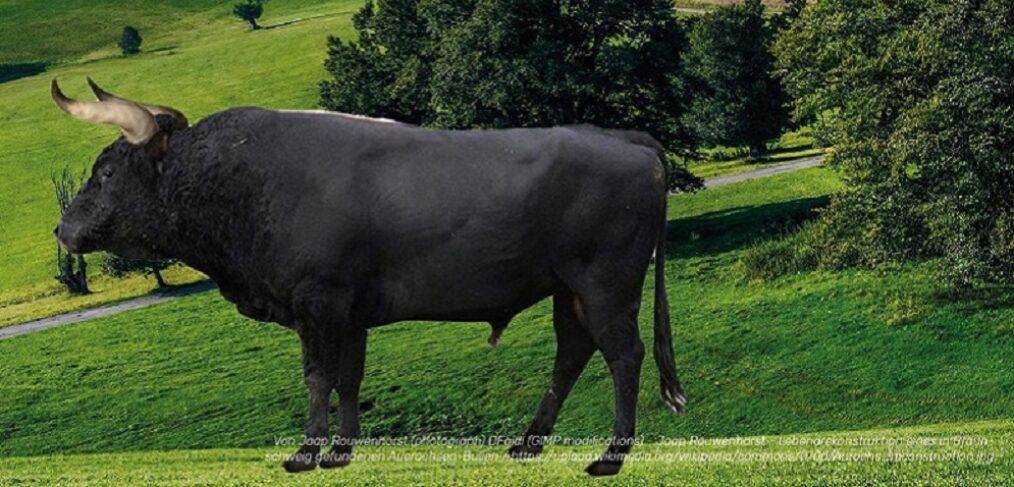
Species of the week #114 – Aurochs
Aurochs (also known as “Ur”) were probably the ancestors of today’s cattle and finally died out at the beginning of modern times. They. But as domestic animals, capercaillies were impractical: too fast, too big, too skittish, too few offspring. Therefore, about 8000 years ago, humans began to breed smaller, calmer animals. The last Aurcattles lived in remote areas in Poland, Russia and the Baltic States. Since large herbivores play an important role in many ecosystems, attempts are now being made to breed back to produce Aurcattle-like animals.
| Distribution Status | extinct |
| Remaining deposits | none |
| Last sighting | 1627 in Poland |
| Habitat | Very quiet forests, grasslands, wetlands |
| Threat | Habitat loss, hunting |
Aurcattles were among the largest herbivores in post-glacial Europe, although there were regional differences in size, as is known from numerous skeletal finds: in Denmark and northern Germany, the shoulder height of Aurcattle bulls was 155 to 180 centimetres, in Hungary the shoulder height of bulls was only 155 to 160 centimetres. The weight of the Auercattle was probably between 700 and 1,000 kilograms, as with bison and bantengs. Auercows were reddish-brown, while the bulls had a pure black colouring, except for the light eel line on their backs and the white outline of their mouths. Compared to their domesticated form, Ure possessed long and slender legs. Due to their large horns, their skulls were much larger and longer than those of domestic cattle. Aurcattlbulls in particular had very pronounced neck and shoulder muscles, which formed the so-called shoulder hump. This is still found today in Spanish fighting cattle, which are bred for bullfights. With the help of computer simulation, a living reconstruction of a Aurcattle bull found in Braunschweig was achieved. The skeleton served as a direct reference for the proportions and horns. Body shape and colour are based on current knowledge about the Aurcattles.
A preferred habitat of the Aurcattles must have been around the Upper Rhine. A particularly large number of bones have been found here. The exact habitat preferences of the Aurcattle are unclear. The species seems to have preferred swamps and marshy forests, such as river valleys, river deltas and bogs, but probably also lived in drier forests and perhaps in open landscapes. In Europe, there may have been an ecological division between the preferred habitat of the Aurcattle and the European bison, with Aurcattles living in slightly wetter forests and European bison in slightly drier forests, although the niches of these two species almost certainly overlapped.
Until its extinction in the 17th century, the Aurcattles shaped the ecosystems it inhabited like few other large herbivores. Through their feeding behaviour, Aurcattles created semi-open landscapes characterised by a particularly high species diversity. Today, these species-rich habitats have all but disappeared in Europe.
The Aurcattle project at the Lauresham open-air laboratory in Lorsch is trying to breed a breed of cattle that is as close as possible to the Aurcattle in terms of appearance, behaviour and genetics. The orientation towards the wild form aims to breed animals that are particularly suitable for near-natural, extensive year-round grazing projects in nature conservation and landscape development.
The growing population, forest clearing and settlement construction gradually displaced the Aurcattle from their habitat. In addition, domesticated cattle disputed the feeding grounds of the Aurcattle. Livestock diseases and hunting also caused the disappearance of the species.
Political necessity:
– Support ecosystem research on large herbivores.
– Renaturation
– strict protection of all endangered species
Click here for more exciting species of the week
Photo : By Aurochs1, Perfect Vision Graphics 513-233-7933 – Own work, CC0, https://commons.wikimedia.org/w/index.php?curid=18467703
